Intercultural Competence In Business
VerifiedAdded on 2023/01/04
|8
|2472
|90
AI Summary
This report discusses the importance of intercultural competence in the global workplace and focuses on a case study about Anna and her challenges in a cross-cultural environment. It explores the reasons behind Anna's communication issues and provides advice on improving intercultural communication. The report also uses intercultural theories to support the discussion.
Contribute Materials
Your contribution can guide someone’s learning journey. Share your
documents today.
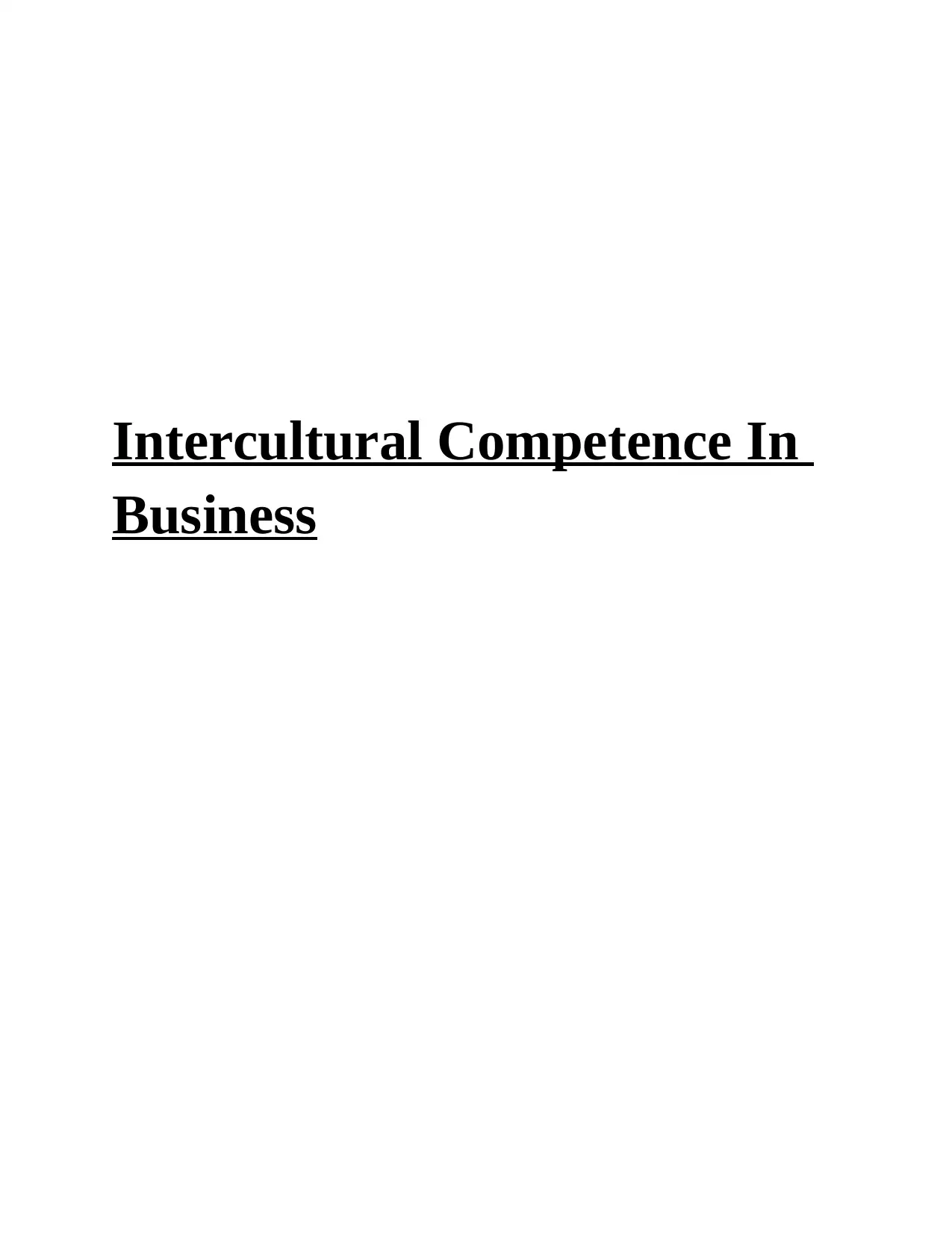
Intercultural Competence In
Business
Business
Secure Best Marks with AI Grader
Need help grading? Try our AI Grader for instant feedback on your assignments.
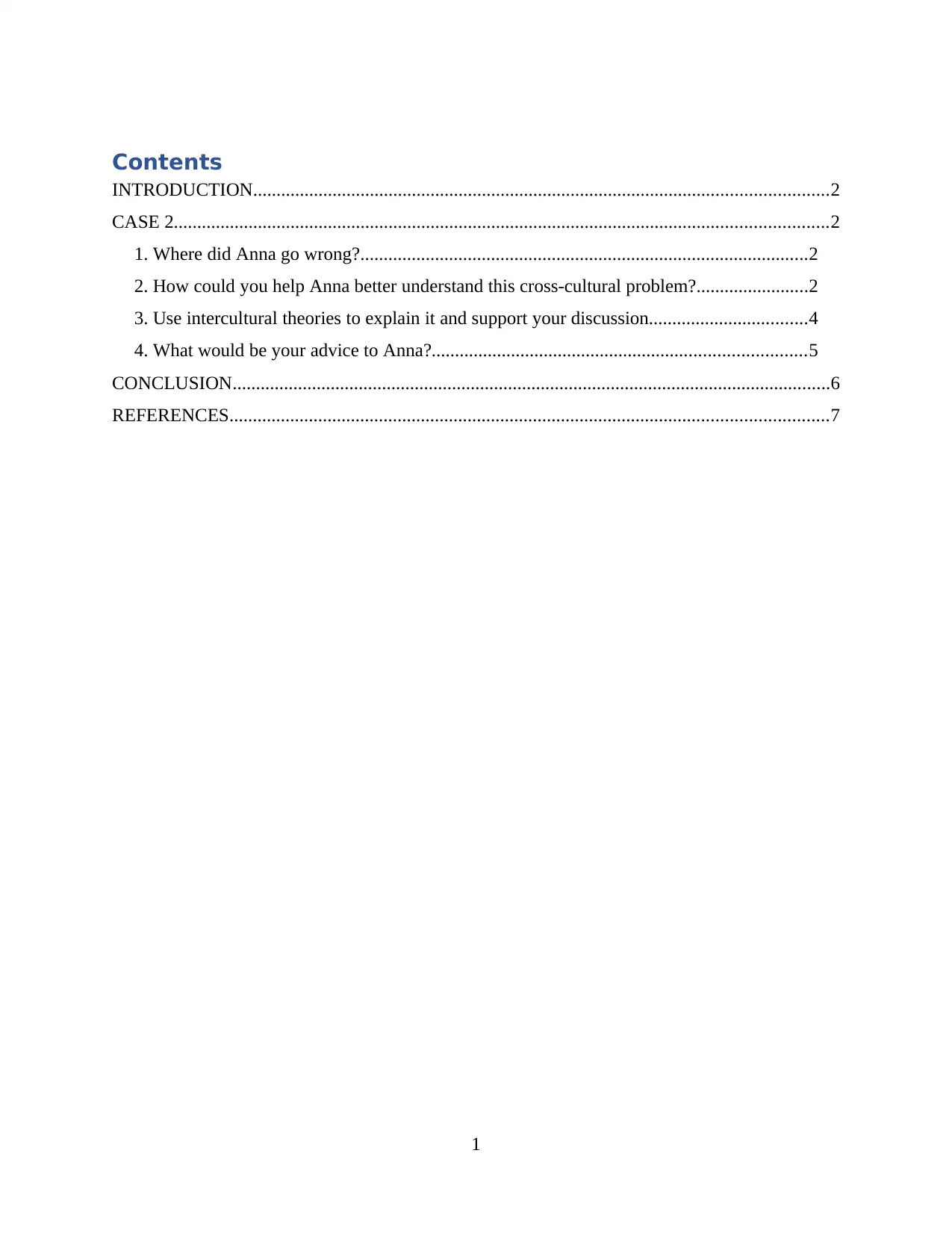
Contents
INTRODUCTION...........................................................................................................................2
CASE 2............................................................................................................................................2
1. Where did Anna go wrong?................................................................................................2
2. How could you help Anna better understand this cross-cultural problem?........................2
3. Use intercultural theories to explain it and support your discussion..................................4
4. What would be your advice to Anna?................................................................................5
CONCLUSION................................................................................................................................6
REFERENCES................................................................................................................................7
1
INTRODUCTION...........................................................................................................................2
CASE 2............................................................................................................................................2
1. Where did Anna go wrong?................................................................................................2
2. How could you help Anna better understand this cross-cultural problem?........................2
3. Use intercultural theories to explain it and support your discussion..................................4
4. What would be your advice to Anna?................................................................................5
CONCLUSION................................................................................................................................6
REFERENCES................................................................................................................................7
1
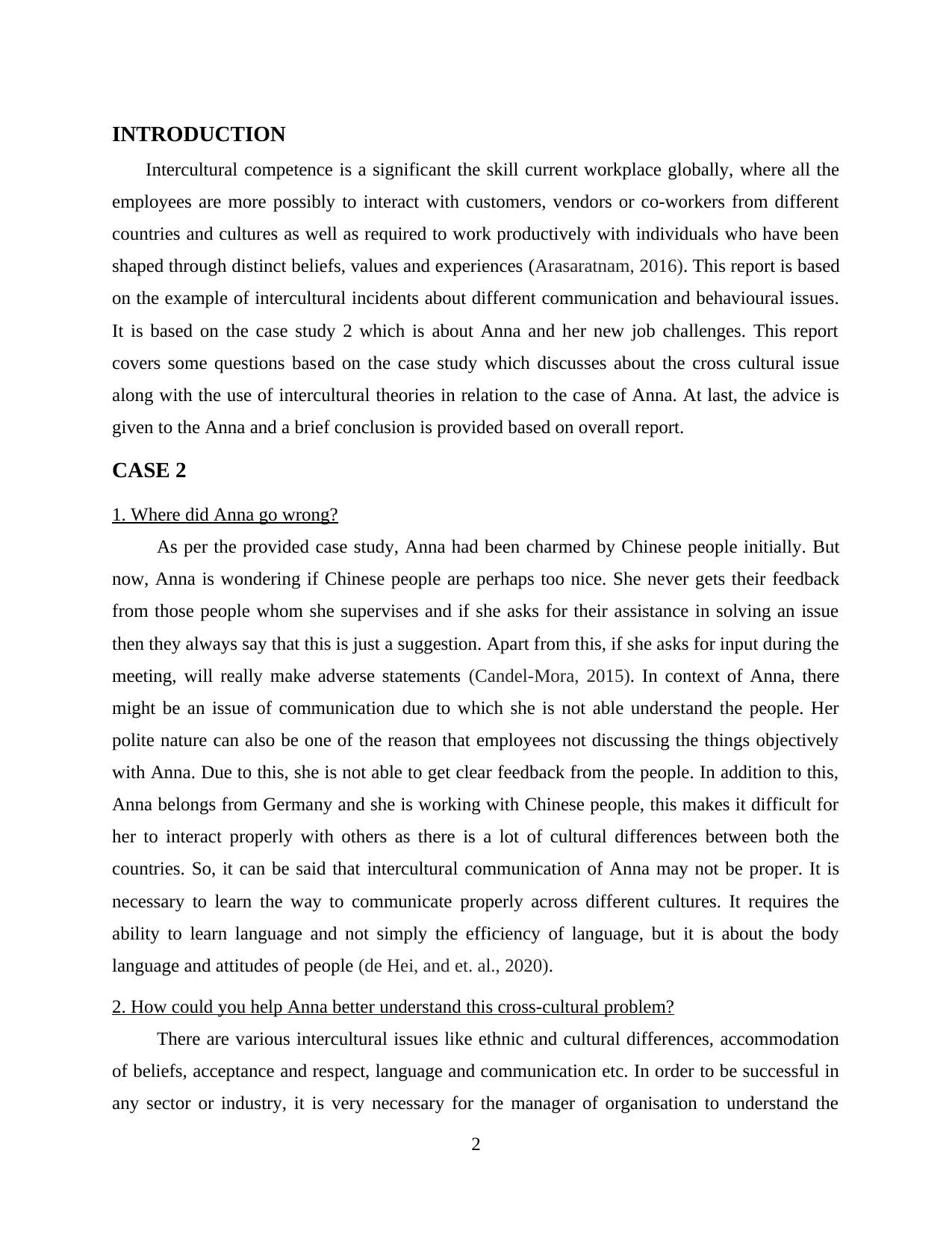
INTRODUCTION
Intercultural competence is a significant the skill current workplace globally, where all the
employees are more possibly to interact with customers, vendors or co-workers from different
countries and cultures as well as required to work productively with individuals who have been
shaped through distinct beliefs, values and experiences (Arasaratnam, 2016). This report is based
on the example of intercultural incidents about different communication and behavioural issues.
It is based on the case study 2 which is about Anna and her new job challenges. This report
covers some questions based on the case study which discusses about the cross cultural issue
along with the use of intercultural theories in relation to the case of Anna. At last, the advice is
given to the Anna and a brief conclusion is provided based on overall report.
CASE 2
1. Where did Anna go wrong?
As per the provided case study, Anna had been charmed by Chinese people initially. But
now, Anna is wondering if Chinese people are perhaps too nice. She never gets their feedback
from those people whom she supervises and if she asks for their assistance in solving an issue
then they always say that this is just a suggestion. Apart from this, if she asks for input during the
meeting, will really make adverse statements (Candel-Mora, 2015). In context of Anna, there
might be an issue of communication due to which she is not able understand the people. Her
polite nature can also be one of the reason that employees not discussing the things objectively
with Anna. Due to this, she is not able to get clear feedback from the people. In addition to this,
Anna belongs from Germany and she is working with Chinese people, this makes it difficult for
her to interact properly with others as there is a lot of cultural differences between both the
countries. So, it can be said that intercultural communication of Anna may not be proper. It is
necessary to learn the way to communicate properly across different cultures. It requires the
ability to learn language and not simply the efficiency of language, but it is about the body
language and attitudes of people (de Hei, and et. al., 2020).
2. How could you help Anna better understand this cross-cultural problem?
There are various intercultural issues like ethnic and cultural differences, accommodation
of beliefs, acceptance and respect, language and communication etc. In order to be successful in
any sector or industry, it is very necessary for the manager of organisation to understand the
2
Intercultural competence is a significant the skill current workplace globally, where all the
employees are more possibly to interact with customers, vendors or co-workers from different
countries and cultures as well as required to work productively with individuals who have been
shaped through distinct beliefs, values and experiences (Arasaratnam, 2016). This report is based
on the example of intercultural incidents about different communication and behavioural issues.
It is based on the case study 2 which is about Anna and her new job challenges. This report
covers some questions based on the case study which discusses about the cross cultural issue
along with the use of intercultural theories in relation to the case of Anna. At last, the advice is
given to the Anna and a brief conclusion is provided based on overall report.
CASE 2
1. Where did Anna go wrong?
As per the provided case study, Anna had been charmed by Chinese people initially. But
now, Anna is wondering if Chinese people are perhaps too nice. She never gets their feedback
from those people whom she supervises and if she asks for their assistance in solving an issue
then they always say that this is just a suggestion. Apart from this, if she asks for input during the
meeting, will really make adverse statements (Candel-Mora, 2015). In context of Anna, there
might be an issue of communication due to which she is not able understand the people. Her
polite nature can also be one of the reason that employees not discussing the things objectively
with Anna. Due to this, she is not able to get clear feedback from the people. In addition to this,
Anna belongs from Germany and she is working with Chinese people, this makes it difficult for
her to interact properly with others as there is a lot of cultural differences between both the
countries. So, it can be said that intercultural communication of Anna may not be proper. It is
necessary to learn the way to communicate properly across different cultures. It requires the
ability to learn language and not simply the efficiency of language, but it is about the body
language and attitudes of people (de Hei, and et. al., 2020).
2. How could you help Anna better understand this cross-cultural problem?
There are various intercultural issues like ethnic and cultural differences, accommodation
of beliefs, acceptance and respect, language and communication etc. In order to be successful in
any sector or industry, it is very necessary for the manager of organisation to understand the
2
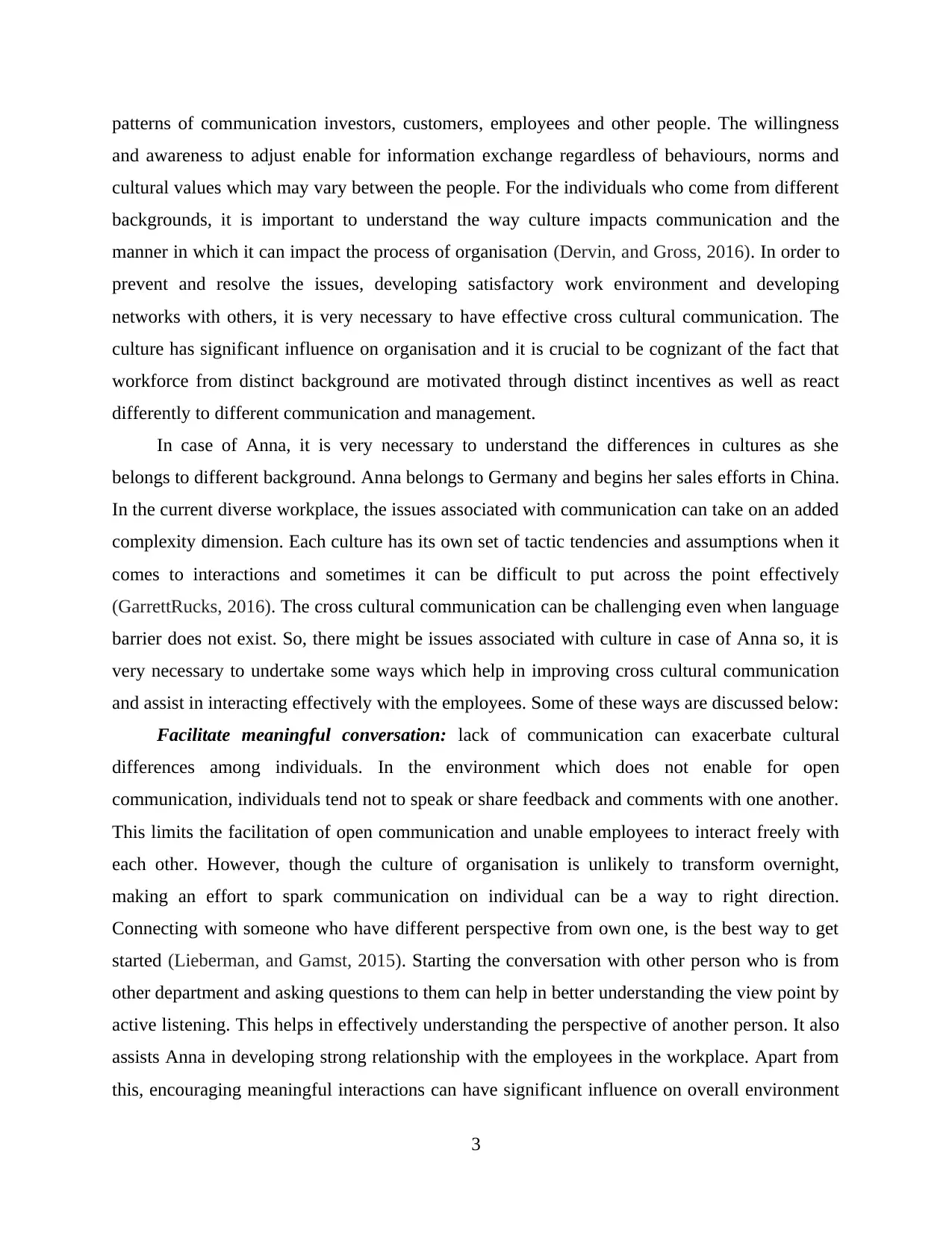
patterns of communication investors, customers, employees and other people. The willingness
and awareness to adjust enable for information exchange regardless of behaviours, norms and
cultural values which may vary between the people. For the individuals who come from different
backgrounds, it is important to understand the way culture impacts communication and the
manner in which it can impact the process of organisation (Dervin, and Gross, 2016). In order to
prevent and resolve the issues, developing satisfactory work environment and developing
networks with others, it is very necessary to have effective cross cultural communication. The
culture has significant influence on organisation and it is crucial to be cognizant of the fact that
workforce from distinct background are motivated through distinct incentives as well as react
differently to different communication and management.
In case of Anna, it is very necessary to understand the differences in cultures as she
belongs to different background. Anna belongs to Germany and begins her sales efforts in China.
In the current diverse workplace, the issues associated with communication can take on an added
complexity dimension. Each culture has its own set of tactic tendencies and assumptions when it
comes to interactions and sometimes it can be difficult to put across the point effectively
(GarrettRucks, 2016). The cross cultural communication can be challenging even when language
barrier does not exist. So, there might be issues associated with culture in case of Anna so, it is
very necessary to undertake some ways which help in improving cross cultural communication
and assist in interacting effectively with the employees. Some of these ways are discussed below:
Facilitate meaningful conversation: lack of communication can exacerbate cultural
differences among individuals. In the environment which does not enable for open
communication, individuals tend not to speak or share feedback and comments with one another.
This limits the facilitation of open communication and unable employees to interact freely with
each other. However, though the culture of organisation is unlikely to transform overnight,
making an effort to spark communication on individual can be a way to right direction.
Connecting with someone who have different perspective from own one, is the best way to get
started (Lieberman, and Gamst, 2015). Starting the conversation with other person who is from
other department and asking questions to them can help in better understanding the view point by
active listening. This helps in effectively understanding the perspective of another person. It also
assists Anna in developing strong relationship with the employees in the workplace. Apart from
this, encouraging meaningful interactions can have significant influence on overall environment
3
and awareness to adjust enable for information exchange regardless of behaviours, norms and
cultural values which may vary between the people. For the individuals who come from different
backgrounds, it is important to understand the way culture impacts communication and the
manner in which it can impact the process of organisation (Dervin, and Gross, 2016). In order to
prevent and resolve the issues, developing satisfactory work environment and developing
networks with others, it is very necessary to have effective cross cultural communication. The
culture has significant influence on organisation and it is crucial to be cognizant of the fact that
workforce from distinct background are motivated through distinct incentives as well as react
differently to different communication and management.
In case of Anna, it is very necessary to understand the differences in cultures as she
belongs to different background. Anna belongs to Germany and begins her sales efforts in China.
In the current diverse workplace, the issues associated with communication can take on an added
complexity dimension. Each culture has its own set of tactic tendencies and assumptions when it
comes to interactions and sometimes it can be difficult to put across the point effectively
(GarrettRucks, 2016). The cross cultural communication can be challenging even when language
barrier does not exist. So, there might be issues associated with culture in case of Anna so, it is
very necessary to undertake some ways which help in improving cross cultural communication
and assist in interacting effectively with the employees. Some of these ways are discussed below:
Facilitate meaningful conversation: lack of communication can exacerbate cultural
differences among individuals. In the environment which does not enable for open
communication, individuals tend not to speak or share feedback and comments with one another.
This limits the facilitation of open communication and unable employees to interact freely with
each other. However, though the culture of organisation is unlikely to transform overnight,
making an effort to spark communication on individual can be a way to right direction.
Connecting with someone who have different perspective from own one, is the best way to get
started (Lieberman, and Gamst, 2015). Starting the conversation with other person who is from
other department and asking questions to them can help in better understanding the view point by
active listening. This helps in effectively understanding the perspective of another person. It also
assists Anna in developing strong relationship with the employees in the workplace. Apart from
this, encouraging meaningful interactions can have significant influence on overall environment
3
Secure Best Marks with AI Grader
Need help grading? Try our AI Grader for instant feedback on your assignments.
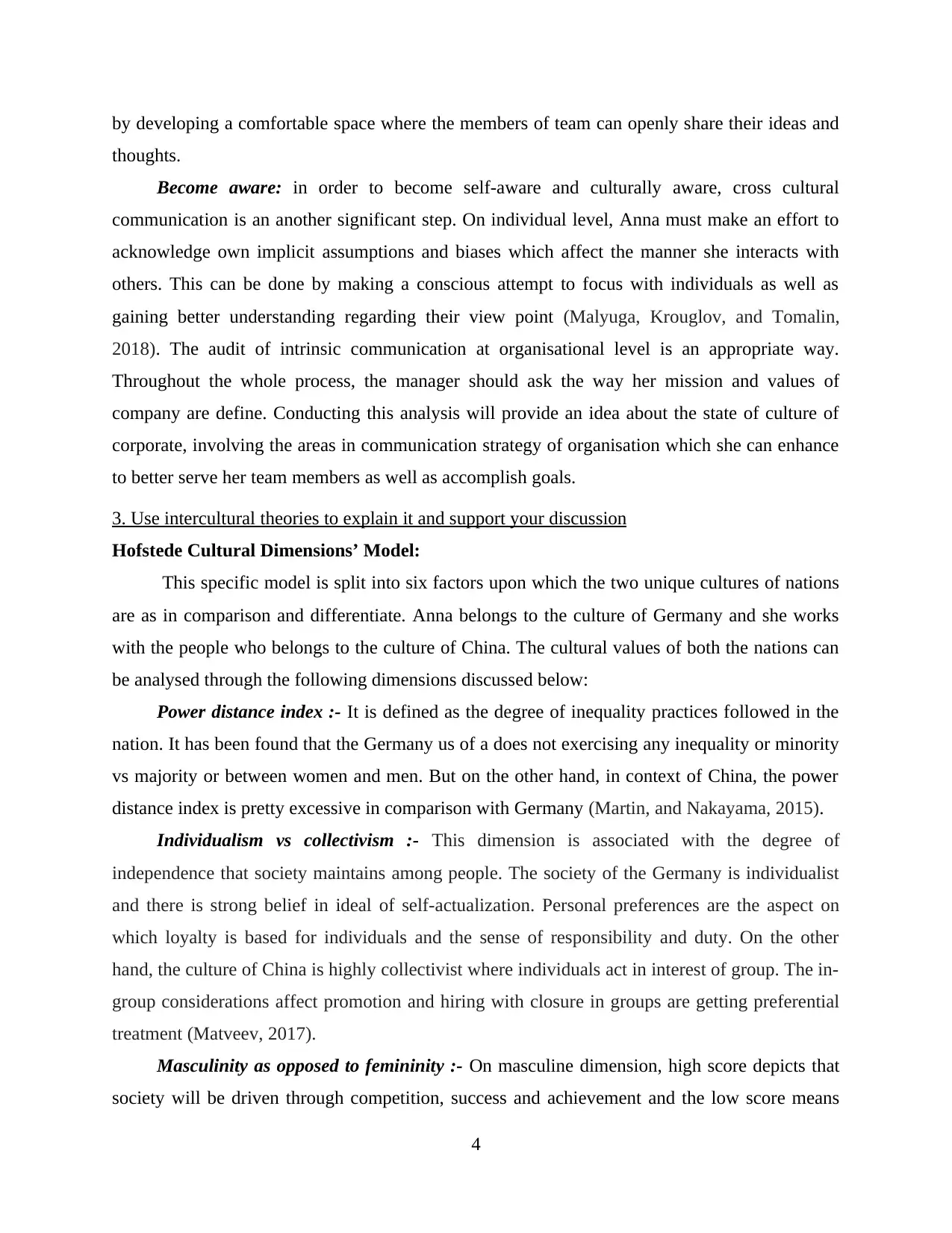
by developing a comfortable space where the members of team can openly share their ideas and
thoughts.
Become aware: in order to become self-aware and culturally aware, cross cultural
communication is an another significant step. On individual level, Anna must make an effort to
acknowledge own implicit assumptions and biases which affect the manner she interacts with
others. This can be done by making a conscious attempt to focus with individuals as well as
gaining better understanding regarding their view point (Malyuga, Krouglov, and Tomalin,
2018). The audit of intrinsic communication at organisational level is an appropriate way.
Throughout the whole process, the manager should ask the way her mission and values of
company are define. Conducting this analysis will provide an idea about the state of culture of
corporate, involving the areas in communication strategy of organisation which she can enhance
to better serve her team members as well as accomplish goals.
3. Use intercultural theories to explain it and support your discussion
Hofstede Cultural Dimensions’ Model:
This specific model is split into six factors upon which the two unique cultures of nations
are as in comparison and differentiate. Anna belongs to the culture of Germany and she works
with the people who belongs to the culture of China. The cultural values of both the nations can
be analysed through the following dimensions discussed below:
Power distance index :- It is defined as the degree of inequality practices followed in the
nation. It has been found that the Germany us of a does not exercising any inequality or minority
vs majority or between women and men. But on the other hand, in context of China, the power
distance index is pretty excessive in comparison with Germany (Martin, and Nakayama, 2015).
Individualism vs collectivism :- This dimension is associated with the degree of
independence that society maintains among people. The society of the Germany is individualist
and there is strong belief in ideal of self-actualization. Personal preferences are the aspect on
which loyalty is based for individuals and the sense of responsibility and duty. On the other
hand, the culture of China is highly collectivist where individuals act in interest of group. The in-
group considerations affect promotion and hiring with closure in groups are getting preferential
treatment (Matveev, 2017).
Masculinity as opposed to femininity :- On masculine dimension, high score depicts that
society will be driven through competition, success and achievement and the low score means
4
thoughts.
Become aware: in order to become self-aware and culturally aware, cross cultural
communication is an another significant step. On individual level, Anna must make an effort to
acknowledge own implicit assumptions and biases which affect the manner she interacts with
others. This can be done by making a conscious attempt to focus with individuals as well as
gaining better understanding regarding their view point (Malyuga, Krouglov, and Tomalin,
2018). The audit of intrinsic communication at organisational level is an appropriate way.
Throughout the whole process, the manager should ask the way her mission and values of
company are define. Conducting this analysis will provide an idea about the state of culture of
corporate, involving the areas in communication strategy of organisation which she can enhance
to better serve her team members as well as accomplish goals.
3. Use intercultural theories to explain it and support your discussion
Hofstede Cultural Dimensions’ Model:
This specific model is split into six factors upon which the two unique cultures of nations
are as in comparison and differentiate. Anna belongs to the culture of Germany and she works
with the people who belongs to the culture of China. The cultural values of both the nations can
be analysed through the following dimensions discussed below:
Power distance index :- It is defined as the degree of inequality practices followed in the
nation. It has been found that the Germany us of a does not exercising any inequality or minority
vs majority or between women and men. But on the other hand, in context of China, the power
distance index is pretty excessive in comparison with Germany (Martin, and Nakayama, 2015).
Individualism vs collectivism :- This dimension is associated with the degree of
independence that society maintains among people. The society of the Germany is individualist
and there is strong belief in ideal of self-actualization. Personal preferences are the aspect on
which loyalty is based for individuals and the sense of responsibility and duty. On the other
hand, the culture of China is highly collectivist where individuals act in interest of group. The in-
group considerations affect promotion and hiring with closure in groups are getting preferential
treatment (Matveev, 2017).
Masculinity as opposed to femininity :- On masculine dimension, high score depicts that
society will be driven through competition, success and achievement and the low score means
4
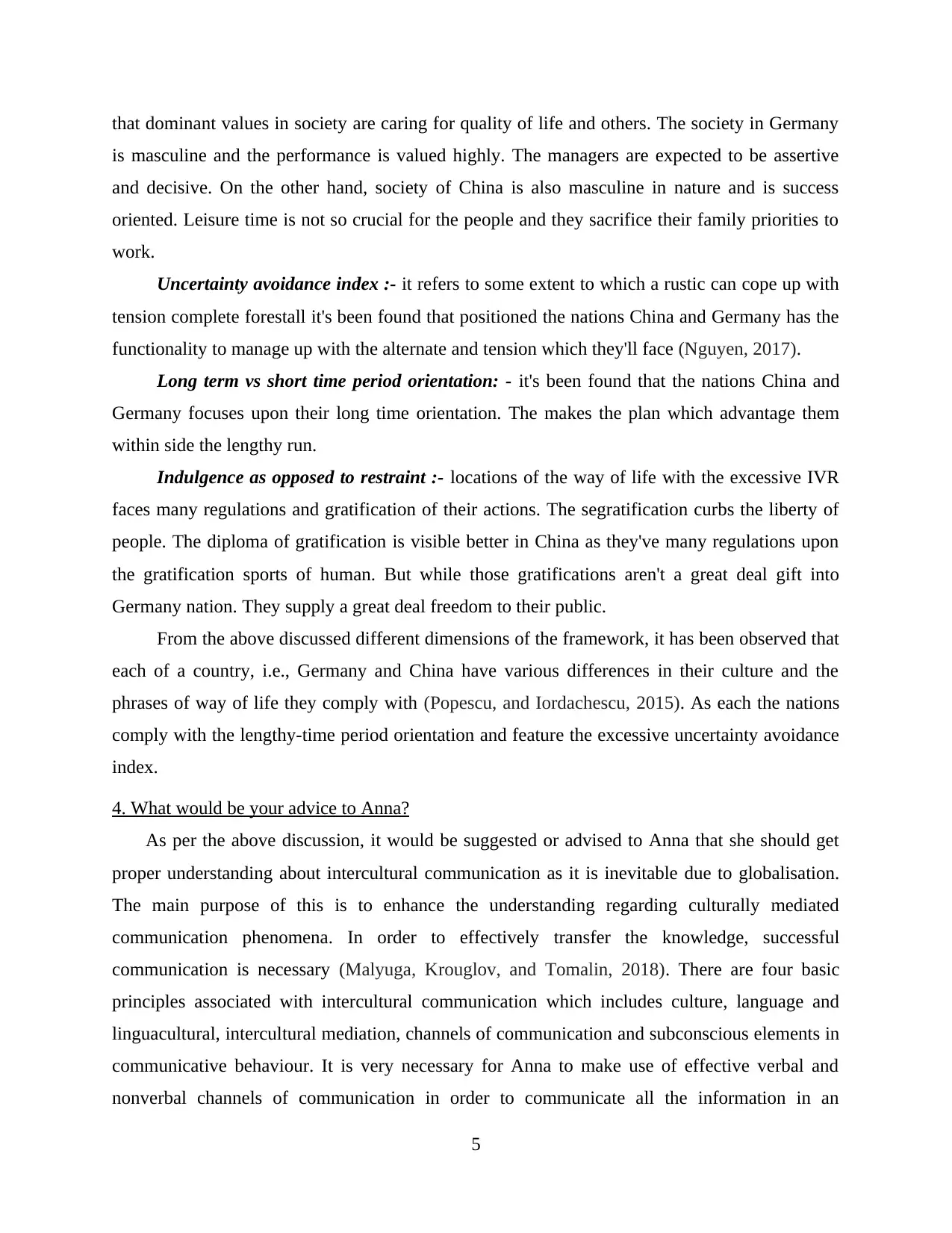
that dominant values in society are caring for quality of life and others. The society in Germany
is masculine and the performance is valued highly. The managers are expected to be assertive
and decisive. On the other hand, society of China is also masculine in nature and is success
oriented. Leisure time is not so crucial for the people and they sacrifice their family priorities to
work.
Uncertainty avoidance index :- it refers to some extent to which a rustic can cope up with
tension complete forestall it's been found that positioned the nations China and Germany has the
functionality to manage up with the alternate and tension which they'll face (Nguyen, 2017).
Long term vs short time period orientation: - it's been found that the nations China and
Germany focuses upon their long time orientation. The makes the plan which advantage them
within side the lengthy run.
Indulgence as opposed to restraint :- locations of the way of life with the excessive IVR
faces many regulations and gratification of their actions. The segratification curbs the liberty of
people. The diploma of gratification is visible better in China as they've many regulations upon
the gratification sports of human. But while those gratifications aren't a great deal gift into
Germany nation. They supply a great deal freedom to their public.
From the above discussed different dimensions of the framework, it has been observed that
each of a country, i.e., Germany and China have various differences in their culture and the
phrases of way of life they comply with (Popescu, and Iordachescu, 2015). As each the nations
comply with the lengthy-time period orientation and feature the excessive uncertainty avoidance
index.
4. What would be your advice to Anna?
As per the above discussion, it would be suggested or advised to Anna that she should get
proper understanding about intercultural communication as it is inevitable due to globalisation.
The main purpose of this is to enhance the understanding regarding culturally mediated
communication phenomena. In order to effectively transfer the knowledge, successful
communication is necessary (Malyuga, Krouglov, and Tomalin, 2018). There are four basic
principles associated with intercultural communication which includes culture, language and
linguacultural, intercultural mediation, channels of communication and subconscious elements in
communicative behaviour. It is very necessary for Anna to make use of effective verbal and
nonverbal channels of communication in order to communicate all the information in an
5
is masculine and the performance is valued highly. The managers are expected to be assertive
and decisive. On the other hand, society of China is also masculine in nature and is success
oriented. Leisure time is not so crucial for the people and they sacrifice their family priorities to
work.
Uncertainty avoidance index :- it refers to some extent to which a rustic can cope up with
tension complete forestall it's been found that positioned the nations China and Germany has the
functionality to manage up with the alternate and tension which they'll face (Nguyen, 2017).
Long term vs short time period orientation: - it's been found that the nations China and
Germany focuses upon their long time orientation. The makes the plan which advantage them
within side the lengthy run.
Indulgence as opposed to restraint :- locations of the way of life with the excessive IVR
faces many regulations and gratification of their actions. The segratification curbs the liberty of
people. The diploma of gratification is visible better in China as they've many regulations upon
the gratification sports of human. But while those gratifications aren't a great deal gift into
Germany nation. They supply a great deal freedom to their public.
From the above discussed different dimensions of the framework, it has been observed that
each of a country, i.e., Germany and China have various differences in their culture and the
phrases of way of life they comply with (Popescu, and Iordachescu, 2015). As each the nations
comply with the lengthy-time period orientation and feature the excessive uncertainty avoidance
index.
4. What would be your advice to Anna?
As per the above discussion, it would be suggested or advised to Anna that she should get
proper understanding about intercultural communication as it is inevitable due to globalisation.
The main purpose of this is to enhance the understanding regarding culturally mediated
communication phenomena. In order to effectively transfer the knowledge, successful
communication is necessary (Malyuga, Krouglov, and Tomalin, 2018). There are four basic
principles associated with intercultural communication which includes culture, language and
linguacultural, intercultural mediation, channels of communication and subconscious elements in
communicative behaviour. It is very necessary for Anna to make use of effective verbal and
nonverbal channels of communication in order to communicate all the information in an
5
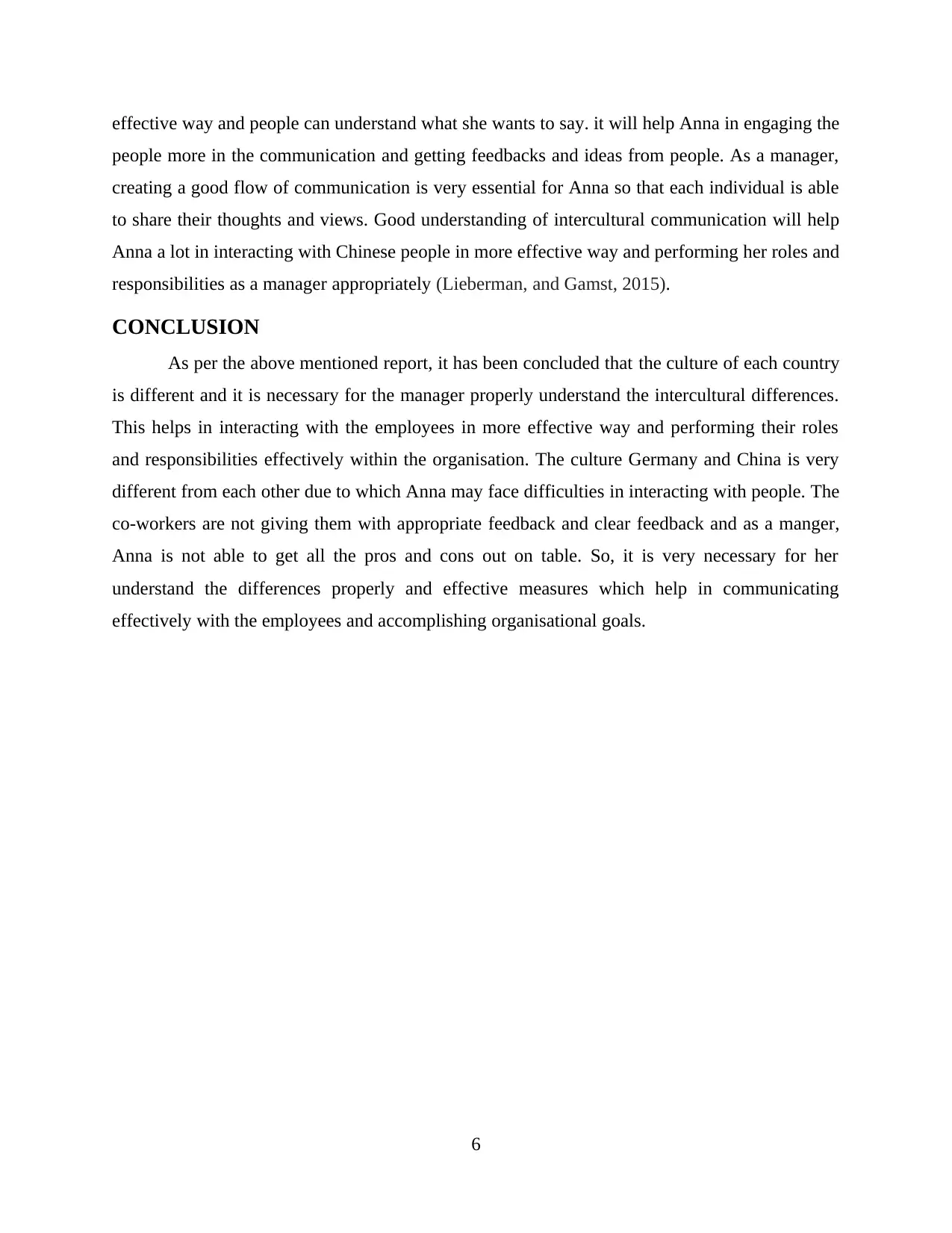
effective way and people can understand what she wants to say. it will help Anna in engaging the
people more in the communication and getting feedbacks and ideas from people. As a manager,
creating a good flow of communication is very essential for Anna so that each individual is able
to share their thoughts and views. Good understanding of intercultural communication will help
Anna a lot in interacting with Chinese people in more effective way and performing her roles and
responsibilities as a manager appropriately (Lieberman, and Gamst, 2015).
CONCLUSION
As per the above mentioned report, it has been concluded that the culture of each country
is different and it is necessary for the manager properly understand the intercultural differences.
This helps in interacting with the employees in more effective way and performing their roles
and responsibilities effectively within the organisation. The culture Germany and China is very
different from each other due to which Anna may face difficulties in interacting with people. The
co-workers are not giving them with appropriate feedback and clear feedback and as a manger,
Anna is not able to get all the pros and cons out on table. So, it is very necessary for her
understand the differences properly and effective measures which help in communicating
effectively with the employees and accomplishing organisational goals.
6
people more in the communication and getting feedbacks and ideas from people. As a manager,
creating a good flow of communication is very essential for Anna so that each individual is able
to share their thoughts and views. Good understanding of intercultural communication will help
Anna a lot in interacting with Chinese people in more effective way and performing her roles and
responsibilities as a manager appropriately (Lieberman, and Gamst, 2015).
CONCLUSION
As per the above mentioned report, it has been concluded that the culture of each country
is different and it is necessary for the manager properly understand the intercultural differences.
This helps in interacting with the employees in more effective way and performing their roles
and responsibilities effectively within the organisation. The culture Germany and China is very
different from each other due to which Anna may face difficulties in interacting with people. The
co-workers are not giving them with appropriate feedback and clear feedback and as a manger,
Anna is not able to get all the pros and cons out on table. So, it is very necessary for her
understand the differences properly and effective measures which help in communicating
effectively with the employees and accomplishing organisational goals.
6
Paraphrase This Document
Need a fresh take? Get an instant paraphrase of this document with our AI Paraphraser
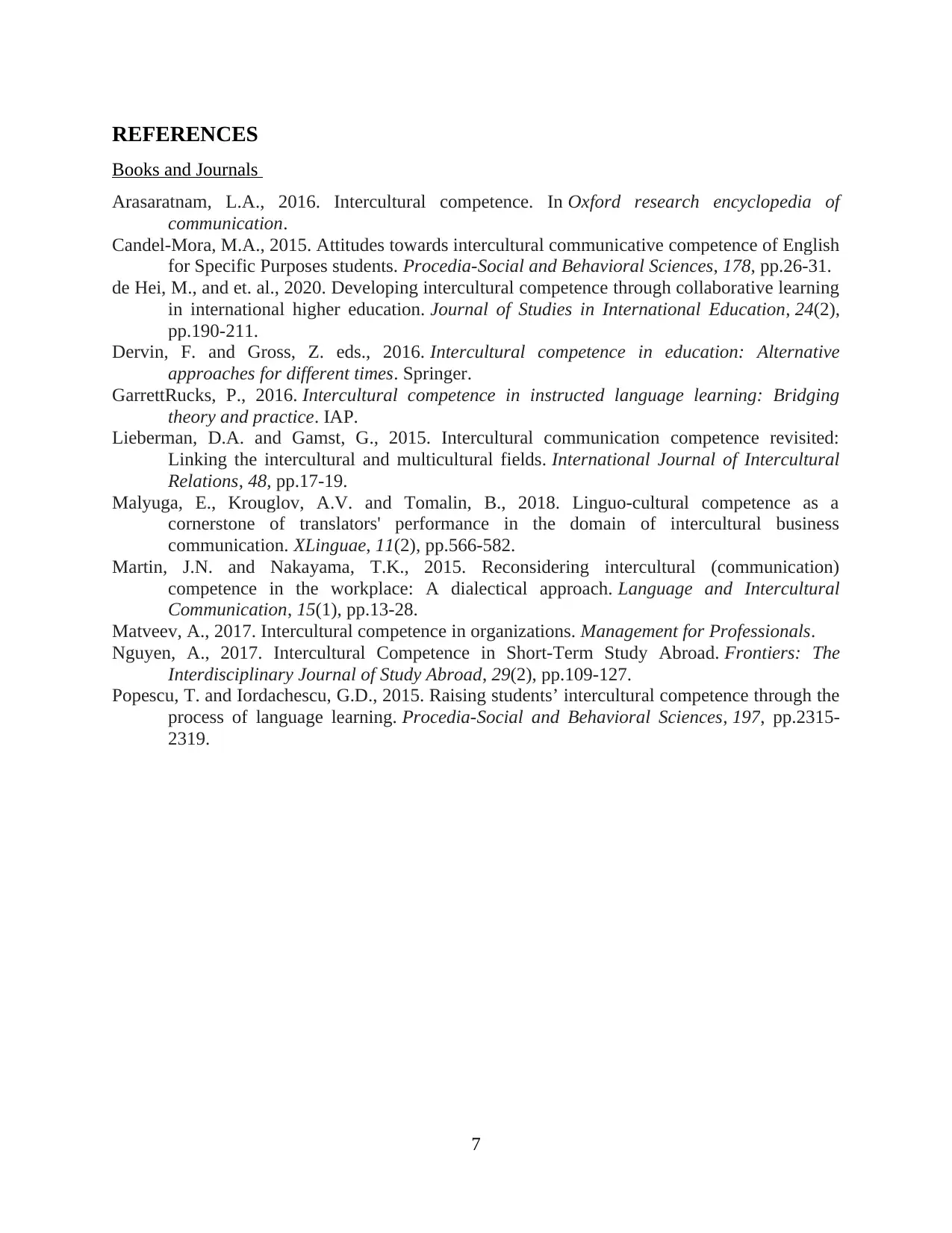
REFERENCES
Books and Journals
Arasaratnam, L.A., 2016. Intercultural competence. In Oxford research encyclopedia of
communication.
Candel-Mora, M.A., 2015. Attitudes towards intercultural communicative competence of English
for Specific Purposes students. Procedia-Social and Behavioral Sciences, 178, pp.26-31.
de Hei, M., and et. al., 2020. Developing intercultural competence through collaborative learning
in international higher education. Journal of Studies in International Education, 24(2),
pp.190-211.
Dervin, F. and Gross, Z. eds., 2016. Intercultural competence in education: Alternative
approaches for different times. Springer.
GarrettRucks, P., 2016. Intercultural competence in instructed language learning: Bridging
theory and practice. IAP.
Lieberman, D.A. and Gamst, G., 2015. Intercultural communication competence revisited:
Linking the intercultural and multicultural fields. International Journal of Intercultural
Relations, 48, pp.17-19.
Malyuga, E., Krouglov, A.V. and Tomalin, B., 2018. Linguo-cultural competence as a
cornerstone of translators' performance in the domain of intercultural business
communication. XLinguae, 11(2), pp.566-582.
Martin, J.N. and Nakayama, T.K., 2015. Reconsidering intercultural (communication)
competence in the workplace: A dialectical approach. Language and Intercultural
Communication, 15(1), pp.13-28.
Matveev, A., 2017. Intercultural competence in organizations. Management for Professionals.
Nguyen, A., 2017. Intercultural Competence in Short-Term Study Abroad. Frontiers: The
Interdisciplinary Journal of Study Abroad, 29(2), pp.109-127.
Popescu, T. and Iordachescu, G.D., 2015. Raising students’ intercultural competence through the
process of language learning. Procedia-Social and Behavioral Sciences, 197, pp.2315-
2319.
7
Books and Journals
Arasaratnam, L.A., 2016. Intercultural competence. In Oxford research encyclopedia of
communication.
Candel-Mora, M.A., 2015. Attitudes towards intercultural communicative competence of English
for Specific Purposes students. Procedia-Social and Behavioral Sciences, 178, pp.26-31.
de Hei, M., and et. al., 2020. Developing intercultural competence through collaborative learning
in international higher education. Journal of Studies in International Education, 24(2),
pp.190-211.
Dervin, F. and Gross, Z. eds., 2016. Intercultural competence in education: Alternative
approaches for different times. Springer.
GarrettRucks, P., 2016. Intercultural competence in instructed language learning: Bridging
theory and practice. IAP.
Lieberman, D.A. and Gamst, G., 2015. Intercultural communication competence revisited:
Linking the intercultural and multicultural fields. International Journal of Intercultural
Relations, 48, pp.17-19.
Malyuga, E., Krouglov, A.V. and Tomalin, B., 2018. Linguo-cultural competence as a
cornerstone of translators' performance in the domain of intercultural business
communication. XLinguae, 11(2), pp.566-582.
Martin, J.N. and Nakayama, T.K., 2015. Reconsidering intercultural (communication)
competence in the workplace: A dialectical approach. Language and Intercultural
Communication, 15(1), pp.13-28.
Matveev, A., 2017. Intercultural competence in organizations. Management for Professionals.
Nguyen, A., 2017. Intercultural Competence in Short-Term Study Abroad. Frontiers: The
Interdisciplinary Journal of Study Abroad, 29(2), pp.109-127.
Popescu, T. and Iordachescu, G.D., 2015. Raising students’ intercultural competence through the
process of language learning. Procedia-Social and Behavioral Sciences, 197, pp.2315-
2319.
7
1 out of 8
Related Documents
Your All-in-One AI-Powered Toolkit for Academic Success.
+13062052269
info@desklib.com
Available 24*7 on WhatsApp / Email
![[object Object]](/_next/static/media/star-bottom.7253800d.svg)
Unlock your academic potential
© 2024 | Zucol Services PVT LTD | All rights reserved.





